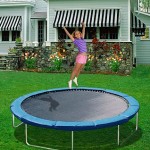Learning To Be Elastic
| August 3, 2011 | Filled under SuperFunTrampolines |
Mechanics of Trampolines — Learning To Be Elastic
In searching for a new blog topic this week, we came across what is essentially the history of the trampoline! A pretty interesting read, if you ask us! ![]()
When was the first time you ever got to try out a trampoline? Most people are introduced to the bouncing fun of trampolines as children, usually at school, or when they get their very own mini trampoline or rebounder as a gift. Even though the motion of jumping up and down on a trampoline mat is so simple, there’s something about it that will never get boring or old. If you’ve ever wondered how the trampoline came to be, or how the mechanics of a trampoline actually work, here are few points of history and physics worth considering. The first thing that you should know is that the modern trampoline was inspired by the circus. George Nissan, a native son of Iowa, was watching trapeze artists perform in a circus act when he came up with the idea. He loved how the gymnasts were able to use the safety net and the force of their fall to bounce themselves into the air for one last jump or trick at the end of their show. Nissan wondered if it would be possible to assemble a device that would provide an elastic jumping surface that could be used over and over again.
The original trampoline was made from pretty crude trampoline parts , like an iron frame and a canvas trampoline mat. Over the years, lighter weight still bars have been used for the frame, and the heavy canvas mat has given way to thin synthetic materials. However, it’s important to realize that it’s not the trampoline mat itself that’s providing the elasticity and bounce. Instead, the elastic nature of the trampoline is provided by the trampoline springs, which are used to suspend the mat inside the frame. When you bounce on the trampoline mat, the springs absorb the impact, and allow the mat to extend down toward the ground. As they recoil to assume their original shape, the resulting force propels you up into the air again. Because of safety concerns associated with the metal frame and springs used to make the traditional trampoline, some people have started to purchase trampoline accessories that can be used to protect both the jumpers and the condition of the trampoline itself. If the trampoline springs are allowed to get stretched, bent, or rusted, it can drastically reduce their elasticity. Stiff springs can mean serious injury, so it’s a good idea to install a trampoline pad or to use a trampoline cover to protect them.
Remember, stay safe and have fun!

Article reprinted with permission. Original found here.
